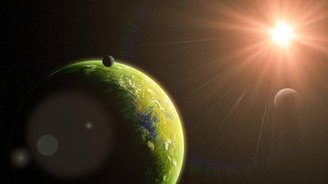Thousands of years ago, ancient scientists believed that the Earth was in a special region of the universe, perhaps even the center of everything. Now science knows that we are nowhere so special, that the planet, life and everything we know was formed by various coincidences and coincidences. But the Rare Earth hypothesis suggests that the celestial object is more unusual than it appears.
Italian physicist Enrico Fermi questioned where all the aliens were because: If planets like Earth are not so special and the universe is so vast, then theoretically there should be extraterrestrial beings. The answer to this question may lie in the Rare Earth hypothesis. An idea that suggests that finding a celestial body with Earth’s characteristics is much more difficult than we might imagine.
To date, no scientific mission has found concrete evidence of extraterrestrial life on other planets and exoplanets, whether molecular life or beings similar to us. It seems like everything is very quiet in the universe and there is only one region where there are night parties, airplanes and fights everywhere: Earth.
In the mid-2000s, paleontologist Peter Ward and astronomer Donald Brownlee published Rare Earth: Why Complex Life is Uncommon in the Universe. and explained the hypothesis that our planet is exceptionalSo how true is this theory?
“Earth appears to be a real gem, a rocky planet where not only liquid water could exist for a long time but where water could also exist as a healthy ocean; not too little, not too much. Our planet appears to be located in a benign part of the galaxy where bombardment from comets and asteroids can be tolerated and habitable zone planets can often grow to Earth size,” the book describes.
Rare Earth Hypothesis
To develop the Rare Earth hypothesis, scientists studied the planet’s various features that are significantly specific and therefore follow from other specific features of the Solar System.
They explain that several unique conditions were necessary for life to develop on Earth; this can be ‘proven’ by the absence of other planets with properties equal to those of the cosmic object we call home.
The authors do not claim that the Earth is special or that it is the center of the universe, but that due to different coincidences in the formation of the cosmos, the planet has developed unique properties that have allowed the formation of complex biological life such as us, humans.
The list of features that the authors mention in the book includes many features such as: A ‘perfect’ planetary tilt that would allow for gentle changes in seasons rather than drastic ones; a moon large enough to keep the planet’s axis stable; the presence of tectonic plates; a molten core that produces the magnetic field that will protect us from the Sun’s radiation; among others.
“Maybe we really are alone. That’s the sobering conclusion of Terra Rara, a book that is sure to have a far-reaching impact on our assessment of our place in the universe. Although complex life is believed to be common, even widespread, across the billions of stars and galaxies in our universe, scientists Peter Ward and Donald Brownlee argue that advanced life may actually be very rare, perhaps even unique. as the book’s jacket describes.
So is Earth really that rare?
Earth seems like a rare celestial body, but perhaps it is not as rare as the book’s researchers believe. When the US National Aeronautics and Space Administration (NASA) published the book in the 2000s, it had discovered very few exoplanets compared to the current number.
At that time, only 11 exoplanets had been detected, and nowMore than 5,743 confirmed in the Milky Way. But more than 10,000 are being analyzed so scientists can figure out whether they fit the characteristics needed for an exoplanet.

There are studies suggesting billions of planets in the Milky Way, so we have only found a few. Many scientists currently believe that there may be cosmic objects with similar properties to Earth. In fact, there are some potentially similar planets being studied, such as the TOI 700 exoplanets of Gliese 12b.
In short, maybe planets like Earth are not as rare as we think, but space missions have not yet been able to confirm that they have the same properties as the celestial body. For now, Earth is unique, but it may not be long before we find a celestial body that is very similar.
Did you like the content? Then share it with your friends, on your social networks and take the opportunity to understand what the Many Worlds interpretation of quantum mechanics is. Until next time, let science answer!
Source: Tec Mundo
I’m Blaine Morgan, an experienced journalist and writer with over 8 years of experience in the tech industry. My expertise lies in writing about technology news and trends, covering everything from cutting-edge gadgets to emerging software developments. I’ve written for several leading publications including Gadget Onus where I am an author.












